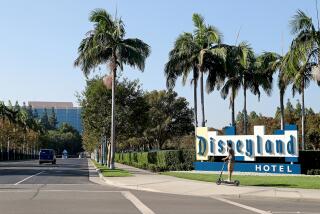SeaWorld reports higher profit but lower attendance
In a rare bit of positive news for SeaWorld Entertainment, the embattled company reported Thursday that its net income rose more than 12% during the third quarter, while revenues showed a much more modest gain, breaking a yearlong string of disappointing earnings reports.
Visitation, though, at the Orlando company’s 11 parks continues to be mixed.
Attendance fell by 0.4% to 8.371 million, a number that would have been higher were it not for declines in its San Diego and San Antonio parks, SeaWorld reported.
Its earnings growth of nearly $11 million came during SeaWorld’s crucial summer quarter, when attendance at the theme parks is at its highest. Revenue, SeaWorld said, rose by 0.2% to $496.9 million compared with the same period a year ago.
“We continue to see early indications that our efforts to improve revenue and profitability are taking hold,” said CEO Joel Manby.
For the first nine months of this year, the company reported drops in both revenue and attendance, noting, though, that it saw growing demand at all but two of its parks, owing to more promotional offerings, strong visitation by regular pass holders and a later Labor Day holiday that can deliver more peak-season visitors to its seasonal parks.
SeaWorld attributed its attendance drop-off in California primarily to “continued SeaWorld brand challenges.” The company, it added, is seeing a “meaningful reduction in the rate of attendance decline in California.”
While SeaWorld Entertainment does not break out attendance for individual parks, visitation to SeaWorld San Diego is known because it is reported as part of its lease with the city, which owns the Mission Bay land where the park sits. Attendance last year fell 17% to nearly 3.7 million, compared with 4.5 million visitors in 2013, the city reported.
Although attendance figures aren’t available for this year, San Diego’s lease income from SeaWorld through the end of September is down nearly 8% compared with the same period a year earlier, according to the city’s real estate assets department.
SeaWorld’s latest earnings report, while painting an improved picture from a year ago when earnings plunged 28% and attendance across all parks fell 5.2%, still reflects a company struggling to regain its financial footing.
Revenues and attendance have suffered over the past year as negative publicity about SeaWorld continues to escalate since the 2013 release of the documentary “Blackfish,” critical of the marine parks’ treatment of their killer whales.
Animal rights groups, most notably People for the Ethical Treatment of Animals, have capitalized on the widespread attention the film garnered, leading SeaWorld to push back with a multimillion-dollar advertising campaign of its own defending the treatment of its marine mammals and highlighting its rescues of stranded animals.
On the bright side for SeaWorld investors, the stock price, at $19.52 on Wednesday’s market close, has been inching up in recent months, although it’s still down more than 40% from its $33.52 share price when it went public in April 2013. And the company was able to eke out a slight increase in third-quarter revenue, growing from $495.8 million to $496.9 million.
But the company still faces major challenges. It suffered a stunning blow last month when the California Coastal Commission said the San Diego park no longer could continue breeding its orcas as a condition of being allowed to significantly enlarge its killer whale tanks.
Facing the prospect of an eventual demise of its signature Shamu shows, SeaWorld vowed to fight the ban and is intending to file a lawsuit challenging the commission’s legal authority to regulate its animal population.
The company also is appealing citations issued earlier this year by California regulators alleging that the San Diego park did not adequately protect its killer whale trainers.
The third-quarter earnings report arrives just days before SeaWorld CEO Joel Manby is set to unveil on Monday his strategy for the company and how it plans to “generate a sustainable increase in shareholder value.” That presentation will come during a webcast that will feature other senior management.
Manby was hired in March after former CEO Jim Atchison stepped down amid growing troubles besetting the company. In recent months, the company has made some key executive changes, hiring a new chief financial officer and chief creative officer.






